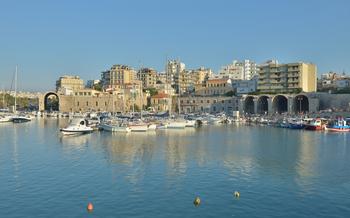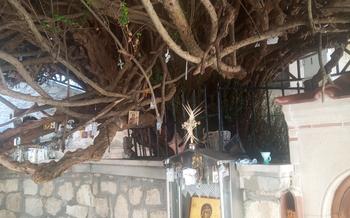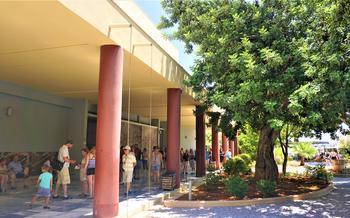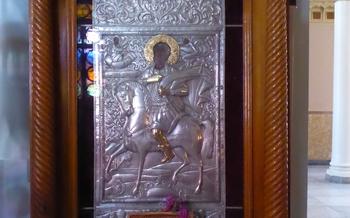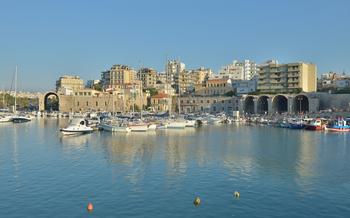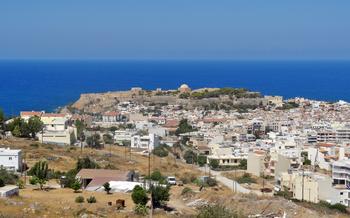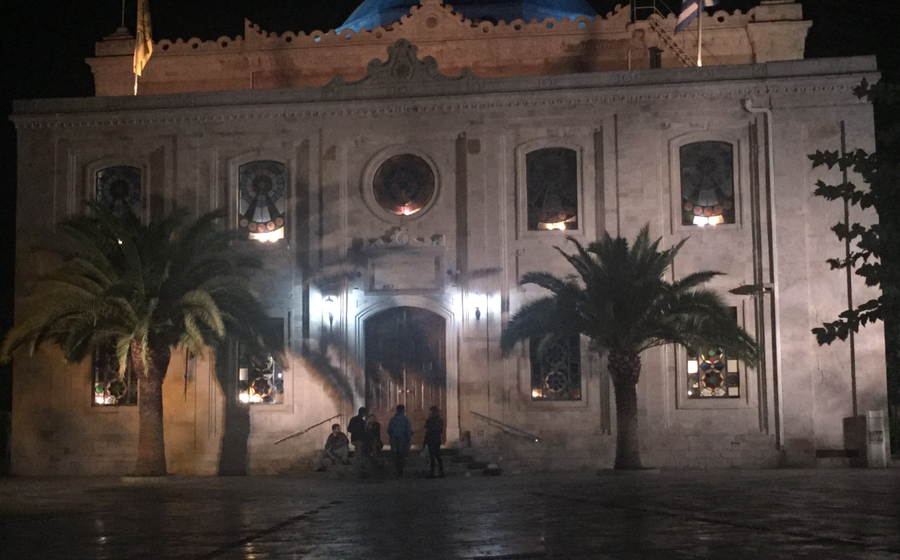
Agios Titos Church
- Historical Significance
- Architectural Beauty
- Religious Importance
- Cultural Landmark
- Location and Accessibility
- Visiting Hours and Admission
- What to See and Experience
- Dress Code and Etiquette
- Photography and Videography
- Souvenirs and Merchandise
- Local Cuisine and Restaurants
- Nearby Attractions
- Historical Context
- Restoration and Preservation: A Labor of Love
- Insider Tip:
Historical Significance
The Agios Titos Church stands as a testament to the rich history of Heraklion and its profound religious and cultural heritage. Built in the 9th century during the Byzantine Empire, the church served as the seat of the Archbishop of Crete and played a pivotal role in the religious and political life of the island. Its construction marked a significant chapter in the city's history, symbolizing the deep-rooted Christian faith of the local population. Over the centuries, the church has witnessed numerous historical events, including the Venetian occupation of Crete, which left its architectural imprint on the building. Today, the Agios Titos Church stands as a living monument, revered by locals and visitors alike, embodying the enduring spirit of Heraklion's past.
Architectural Beauty
The Agios Titos Church stands as a testament to the architectural ingenuity of its creators, showcasing a harmonious blend of Byzantine and Venetian influences. Its exterior facade is adorned with intricate stone carvings and decorative elements, reflecting the meticulous craftsmanship of the era. The church's interior is equally impressive, featuring a spacious nave supported by rows of elegant columns. The walls are adorned with vibrant frescoes depicting biblical scenes and the lives of saints, creating a visually captivating atmosphere. The domed ceiling, a hallmark of Byzantine architecture, adds a sense of grandeur and spirituality to the space. The church's iconostasis, a beautifully carved wooden screen separating the sanctuary from the nave, is a masterpiece in itself, featuring intricate carvings and exquisite religious iconography. The overall architectural design of the Agios Titos Church reflects a fusion of cultural influences, showcasing the diverse history and artistic heritage of Heraklion.
Religious Importance
The Agios Titos Church holds immense religious significance to the Greek Orthodox community of Heraklion, serving as a sacred place of worship and spirituality. Throughout the year, the church hosts a variety of religious rituals and ceremonies that draw worshippers from across the city and beyond. Every Sunday, the church comes alive with the melodious sound of Byzantine hymns and the fervent prayers of the congregation. During major religious festivals, such as Easter and Christmas, the church is adorned with intricate decorations and elaborate ceremonies are held, attracting hundreds of faithful attendees.
The Agios Titos Church is not merely a building but a living testament to the deep-rooted faith and traditions of the Greek Orthodox community. Its spiritual aura and the unwavering devotion of its worshippers create a profound and moving atmosphere that resonates with visitors of all backgrounds, inviting them to connect with the divine. Whether seeking solace, guidance, or a deeper connection with their faith, people find comfort and inspiration within the walls of this sacred church.
Cultural Landmark
The Agios Titos Church stands as a testament to Crete's rich heritage and cultural identity. Over the centuries, it has become an integral part of the city's fabric, embodying the religious and cultural traditions of the local community. The church's unique architectural style, intricate artwork, and spiritual significance have made it a beloved landmark among locals and visitors alike.
The Agios Titos Church is closely associated with the history and culture of Heraklion. It has played a pivotal role in the city's religious and cultural life, hosting major religious festivals, ceremonies, and events throughout the year. The church is also a popular destination for pilgrims and tourists who come to admire its architectural beauty and learn about its historical significance.
In addition to its religious significance, the Agios Titos Church has also become a cultural symbol of Heraklion and Crete. Its unique architecture and artistic features have made it a popular subject for artists, photographers, and writers. The church has been featured in numerous works of art, literature, and music, further solidifying its status as a cultural icon.
To fully appreciate the cultural significance of the Agios Titos Church, visitors are encouraged to attend one of the many religious services or festivals held throughout the year. These events offer a glimpse into the vibrant religious traditions of the local community and provide an opportunity to witness the church's spiritual significance firsthand.
Location and Accessibility
The Agios Titos Church is strategically positioned in the heart of Heraklion, on the famous 25th August Street, an arterial road brimming with historical and cultural landmarks. This prominent location makes the church effortlessly accessible by foot, allowing visitors to seamlessly integrate a visit to this sacred site into their exploration of the city.
For those arriving by public transportation, the church is conveniently situated near several bus stops, ensuring effortless connectivity from various parts of Heraklion.
Additionally, the church's proximity to other notable landmarks, such as the Venetian Loggia, the Morosini Fountain, and the Heraklion Archaeological Museum, makes it an ideal starting point for a comprehensive exploration of the city's rich heritage.
Visiting Hours and Admission
The Agios Titos Church is open to the public every day of the week, with the exception of major religious holidays. The standard visiting hours are typically from 8:00 AM to 1:00 PM and from 5:00 PM to 8:00 PM. However, these hours may vary depending on the season or special events, so it is advisable to check the church's official website or inquire with local tourist information centers for the most up-to-date information.
Admission to the church is free of charge, allowing visitors to explore and admire its beauty without any financial barriers. The church welcomes people of all faiths and backgrounds to come and experience the spiritual and cultural significance of this sacred space. Visitors are encouraged to dress respectfully, maintain silence, and observe the etiquette expected in a place of worship.
What to See and Experience
As you step inside the Agios Titos Church, prepare to be captivated by its awe-inspiring interior. The church's ornate iconostasis, intricately carved from wood and adorned with gold leaf, is a masterpiece of Byzantine art. Each icon depicts a different saint or biblical scene, inviting visitors to contemplate the sacred narratives that have shaped the Christian faith.
The church's walls are adorned with vibrant frescoes, painted by skilled artisans centuries ago. These frescoes depict scenes from the life of Jesus Christ, the Virgin Mary, and various saints. The vivid colors and expressive brushstrokes bring these stories to life, offering visitors a glimpse into the rich artistic traditions of the Byzantine era.
Don't miss the opportunity to admire the church's impressive collection of religious artifacts, including ancient manuscripts, ornate chalices, and intricately woven tapestries. Each artifact tells a story of devotion, faith, and craftsmanship, providing visitors with a deeper understanding of the church's history and significance.
As you wander through the church, take a moment to pause and reflect on the spiritual atmosphere that permeates the air. The soft glow of candlelight, the scent of incense, and the gentle murmur of prayers create a sense of peace and tranquility, inviting visitors to connect with their inner selves and find solace within the sacred space.
Dress Code and Etiquette
When visiting the Agios Titos Church, it is important to dress respectfully, considering its religious significance. While there is no strict dress code, visitors should avoid wearing shorts, tank tops, or other revealing clothing. Modest attire that covers the shoulders and knees is recommended.
Inside the church, visitors are expected to behave in a respectful and mindful manner. Silence should be maintained to avoid disturbing worshippers or disrupting the spiritual atmosphere. Photography and videography are permitted, but visitors should be discreet and avoid using flash or tripods that may obstruct others or interfere with religious ceremonies.
Photography and Videography
Photography and videography are generally permitted inside the Agios Titos Church, allowing visitors to capture the beauty and grandeur of the sacred space. However, it is crucial to respect the sanctity of the church and adhere to the following guidelines:
-
Use of Tripods: Tripods are generally not allowed inside the church to minimize obstruction and ensure the safety of visitors. It is recommended to use handheld photography or a monopod instead.
-
Flash Photography: Flash photography is strictly prohibited within the church to prevent damage to the delicate artwork and artifacts. Natural light or low-light photography techniques are preferred.
-
Video Recording: Video recording is permitted for personal use, but it is essential to be mindful of other visitors and avoid disrupting religious services or ceremonies.
-
Respect for Worshippers: When taking photos or videos, it is important to be respectful of worshippers and avoid capturing their faces or disturbing their prayers.
-
Capturing the Essence: To capture the best images and videos, visitors should focus on the architectural details, intricate mosaics, and stunning iconography that adorn the church. Using a wide-angle lens can help capture the grandeur of the interior space.
Souvenirs and Merchandise
As a token of remembrance or a gift for loved ones, visitors can purchase souvenirs and merchandise related to the Agios Titos Church. Inside the church, a small shop offers a variety of items, including religious icons, candles, and books on the history and significance of the church. Visitors can also find a selection of locally-crafted handicrafts, such as pottery, jewelry, and textiles, which showcase the vibrant artistic traditions of Crete. These souvenirs not only serve as mementos of a visit to the Agios Titos Church but also contribute to the preservation and promotion of local culture and craftsmanship.
Local Cuisine and Restaurants
After exploring the spiritual and cultural depths of the Agios Titos Church, visitors might want to indulge in the culinary delights of Heraklion. The area surrounding the church offers a diverse range of local restaurants and tavernas where visitors can savor the authentic flavors of Cretan cuisine.
One highly recommended restaurant is [Restaurant Name], located just a short walk from the church. This family-run tavern serves traditional Cretan dishes prepared with fresh, local ingredients. Visitors can expect to find a wide selection of dishes, including succulent grilled meats, flavorful seafood platters, and an array of vegetarian options.
Another popular choice is [Restaurant Name], known for its cozy atmosphere and friendly service. Here, visitors can enjoy a variety of Cretan specialties, such as dakos salad, fresh seafood dishes, and mouthwatering desserts. Vegetarian and vegan options are also available.
For those seeking a more upscale dining experience, [Restaurant Name] offers a contemporary take on Cretan cuisine. This elegant restaurant serves innovative dishes that blend traditional flavors with modern culinary techniques. Visitors can choose from a carefully curated menu that showcases the best of Cretan produce and products.
No matter which restaurant visitors choose, they are sure to be delighted by the vibrant flavors and warm hospitality that characterize Cretan cuisine. Whether it's a hearty lunch or a romantic dinner, a culinary journey awaits those who venture into the culinary haven surrounding the Agios Titos Church.
Nearby Attractions
A visit to the Agios Titos Church can be easily combined with other cultural and historical attractions in Heraklion. Situated within walking distance of the church, the Historical Museum of Crete offers a comprehensive overview of the island's rich past, from the Minoan civilization to the present day. The museum houses an impressive collection of artifacts, including pottery, sculptures, and jewelry, that provide a glimpse into the diverse cultures that have shaped Crete throughout history.
For those interested in the Venetian era, the Venetian Walls are a must-see. These imposing fortifications, built in the 16th century to protect the city from invaders, still encircle the old town of Heraklion. Visitors can walk along the ramparts and enjoy panoramic views of the city and the surrounding countryside.
Another nearby attraction is the Morosini Fountain, an elaborate Venetian fountain located in the heart of the old town. Constructed in 1628, the fountain is a testament to the artistic and cultural influence of the Venetian Republic on Heraklion. Its intricate carvings and sculptures depict mythological figures and scenes from Greek mythology.
These are just a few of the many attractions that visitors can explore in the vicinity of the Agios Titos Church. By combining a visit to the church with these other cultural and historical landmarks, travelers can gain a deeper understanding of the rich heritage and diverse influences that have shaped the city of Heraklion.
Historical Context
The Agios Titos Church stands as a testament to the rich history of Heraklion, Crete. Its construction dates back to the Byzantine Empire, during the reign of Emperor Nikiforos Fokas in the 10th century. The church was built on the site of an ancient temple dedicated to the goddess Artemis, symbolizing the triumph of Christianity over paganism.
During the Venetian rule of Crete, the church underwent significant modifications and embellishments. The Venetians added Gothic elements to the architecture, including pointed arches and ribbed vaults, blending Byzantine and Western influences.
The Agios Titos Church played a pivotal role in the religious and political life of Heraklion. It served as the cathedral of the Greek Orthodox Church on the island and was the site of important ceremonies and celebrations. The church also witnessed significant historical events, including the signing of the Treaty of Heraklion in 1669, which ended the Venetian-Ottoman War.
After the Ottoman conquest of Crete in the 17th century, the church underwent further modifications to adapt to the Islamic rule. Minarets were added to the exterior, and the interior was decorated with Islamic motifs. Despite these changes, the church retained its Christian character and continued to serve as a place of worship for the Greek Orthodox community.
In the 19th century, during the Greek War of Independence, the Agios Titos Church became a symbol of resistance against Ottoman rule. Greek rebels used the church as a meeting place and a refuge, and it played a significant role in the struggle for freedom.
The church has undergone several restorations and renovations over the years to preserve its historical and architectural integrity. In the 20th century, the minarets were removed, and the church was restored to its original Byzantine-Venetian style.
Today, the Agios Titos Church stands as a proud symbol of Heraklion's rich history, blending Byzantine, Venetian, and Ottoman influences. It continues to serve as a place of worship for the Greek Orthodox community and is a popular tourist attraction, attracting visitors from around the world who come to admire its architectural beauty and historical significance.
Restoration and Preservation: A Labor of Love
The Agios Titos Church has undergone several restoration and preservation efforts throughout its long history, each aimed at maintaining its architectural integrity and historical significance. In the late 19th century, the church underwent a major restoration project under the supervision of the Greek Archaeological Society. This project focused on repairing structural damage, restoring the church's original features, and uncovering hidden Byzantine mosaics and frescoes.
More recently, in the 1980s, the church underwent another extensive renovation. This project involved cleaning and repairing the exterior stonework, restoring the interior frescoes and iconostasis, and installing a new roof. The goal of this restoration was to preserve the church's unique architectural features and ensure its longevity for future generations.
Preserving the Agios Titos Church is an ongoing process, and the local community and government authorities play a vital role in protecting this cultural and religious treasure. Regular maintenance and upkeep are carried out to address any issues that may arise, and the church is closely monitored to ensure its safety and integrity.
One of the challenges in preserving the Agios Titos Church is balancing the need for restoration with the desire to maintain its historical authenticity. Conservators and architects must carefully assess any changes or repairs to ensure that they are in keeping with the original design and do not compromise the church's historical significance.
The restoration and preservation efforts have been successful in ensuring that the Agios Titos Church remains a testament to the rich history and religious traditions of Heraklion. The church continues to serve as a place of worship, a cultural landmark, and a symbol of the city's enduring heritage.
Insider Tip:
For an unforgettable experience, plan your visit to coincide with one of the church's many religious festivals. These celebrations, which often take place during the summer months, showcase the vibrant traditions and customs of the local community. Immerse yourself in the lively atmosphere, witness colorful processions, and join the locals in their heartfelt devotions. It's a truly unique opportunity to witness the spiritual essence of the Agios Titos Church and connect with the deep faith that permeates the hearts of its worshippers.

